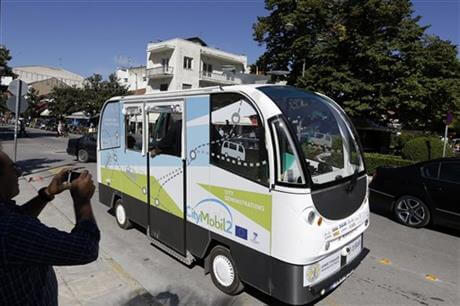
By DEREK GATOPOULOS
There’ll be no arguing with the driver on this bus: the rides are free and there’s no driver anyway.
Trikala, a rural town in northern Greece, has been chosen to test a driverless bus in real traffic conditions for the first time, part of a European project to revolutionize mass transport and wean its cities off oil dependency over the next 30 years.
Trials of the French-built CityMobil2 buses started last week and will last through late February.
Over the past year, CityMobil2 has been tried out near its base in La Rochelle in western France, on a campus in Lausanne, Switzerland, and near Helsinki, Finland, all in controlled conditions that produced no accidents.
But in Greece, a country of narrow, winding, hilly streets, stray dogs, bicycle riders and impatient drivers, the buses are up against real traffic. The Greek government had to amend its laws to allow the testing and the city had to build a dedicated bus lane that deprived residents of downtown parking spaces.
The robot buses don’t look like science fiction vehicles — more like golf cart meets ice-cream truck. Still, heads turn as the skinny, battery-powered buses hum through the streets. They seat only 10 people and are guided by GPS and supplementary sensors, including lasers and cameras, that send live data to a control center.
The buses go no faster than 20 kph (12 1/2 mph), but the trials in Trikala (pronounced TREE-kah-lah) potentially represent a major advance for automated transport.
“There were cities bidding for this project all over Europe. They offered relatively restricted urban areas. But we said we could make it happen in a downtown environment and we won,” said Odisseas Raptis, who heads the city’s digital project department, e-Trikala. “We have a 2.4-kilometer (1.5-mile) route, the bus route. It’s mixed with traffic, with pedestrians, with bicycles, with cars … That hasn’t been done before.”
Vasilis Karavidas, chief technician for the project in Greece, trained with Robosoft, the company that developed the bus, in the southwest French town of Bidart.
Although the driverless buses are fully automated with onboard navigation and obstacle detection systems, each vehicle will be monitored by a driver in the control center who can override the system, Karavidas said.
“It’s as if they are in here and they can stop the bus if they want to, if something goes wrong,” he said.
The buses are currently running without passengers, with full testing to start later this month when a fiber-optic network allowing faster data transmission is completed. Six battery-powered vehicles will eventually be used in this farming town of 80,000 that has become hooked on high-tech.
Trikala already has already tested EU-funded pilot medical programs, including schemes to relay heart test data from home to the doctor’s office and use tracker devices for Alzheimer patients. In the center of the city, a “digital tree” with solar panels allows benches to carry phone-charging outlets.
The 28-nation European Union is targeting gasoline use for city transport as one area where it wants to reduce carbon emissions. With oil prices and city populations expected to rise in the coming decades, a major shift to battery power and more shared transport could blur the line between private and public vehicles.
Senior transport analyst Philippe Crist at the International Transport Forum, an OECD think-tank based in Paris, says transport trends are hard to predict as the world moves more toward automation.
“We too often look at technological changes in isolation,” said Crist. “There is a good chance that these technologies will create entirely new uses that we can only poorly grasp today. The reality is that everything is changing around these technologies and it is plausible that society may lose interest in owning cars or using fixed-service public transport — especially if these technologies allow better alternatives to emerge.”
Models run by the think tank suggest that city transport could be made massively more efficient.
Crist said researchers looked at “shared and route-optimized on-call taxi-like services replacing all car and bus trips in a mid-sized European city. We found that these systems could deliver almost the same mobility as today but with 95 percent fewer vehicles.”
Driverless cars and buses offer an easier way to optimize traffic flow while aiming to eliminate human error. That has transport developers working at both ends: adding automatic features to conventional vehicles while raising the bar for those that will have no driver at all.
So far, the CityMobile2 has had mixed reviews on the streets of Trikala. Not everyone is happy to lose parking spots or replace human jobs with machines. Still, retiree Michalis Pantelis said he was proud that his city was selected for the testing.
“I think it’s wonderful. Think how many people will come to Trikala to see this. It’s new and innovative,” he said, moments after a driverless bus passed by. “It reminds me of the toy cars my grandchildren play with.”
__



